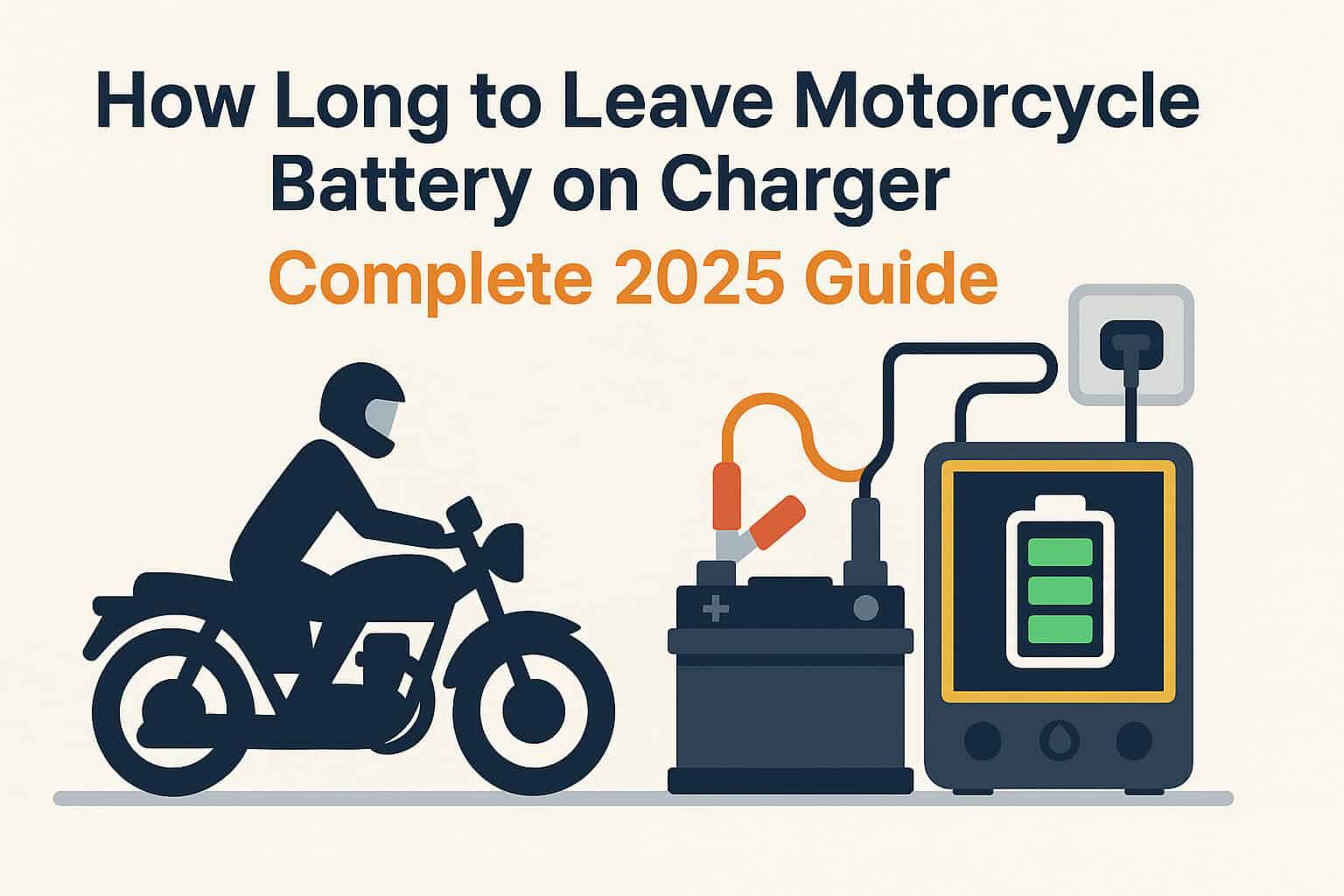How long to leave motorcycle battery on charger is one of the most common questions riders ask—and getting it wrong can cost you a battery.
You’re not alone—this is one of the most common questions riders face, and getting it wrong can cost you big time.
Whether you’re charging a lead-acid, AGM, or lithium-ion battery, the charging duration matters more than you think.
In my early days of riding, I overcharged my bike’s battery thinking “longer must be better.” Spoiler: it wasn’t. The result?
A dead battery within months.
In this updated guide, I’ll explain how long to leave motorcycle battery on charger based on your battery’s type and condition. based on battery type, charger quality, and real-world tips from experience.
We’ll also look at smart chargers, overcharging risks, and maintenance strategies to keep your bike ready to ride—every time.
Understanding Motorcycle Battery Types
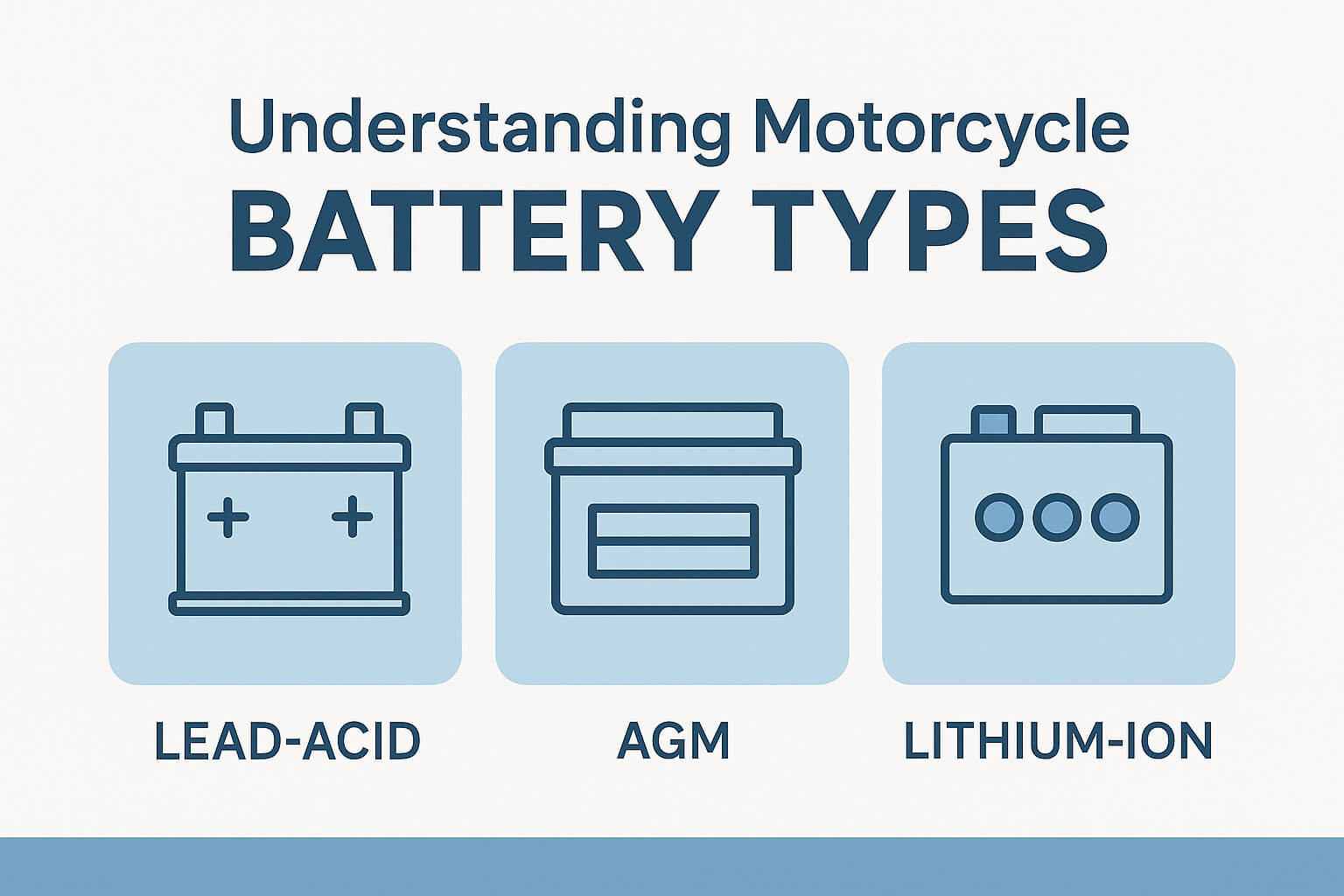
Choosing the right motorcycle battery isn’t just about price—it directly affects how your bike performs and how long your battery lasts between charges.
Over the years, I’ve dealt with all kinds of batteries, and here’s the real talk: not all are created equal.
Let me break down the three main types you’ll come across:
Lead-Acid Batteries
These are your old-school, traditional batteries—affordable and tough, but they need babysitting.
They use a liquid electrolyte, which means you’ve got to check water levels now and then.
Charging them takes time (and patience), but if you’re on a budget and don’t mind a little upkeep, they’ll get the job done.
Pro Tip: Always charge lead-acid batteries slowly with a compatible charger to avoid overheating.
AGM (Absorbed Glass Mat) Batteries
AGM batteries are a modern upgrade.
They’re sealed tight and use a fiberglass mat to hold the electrolyte in place—so there’s no mess, no leaks, and minimal maintenance.
They also affect how long to leave motorcycle battery on charger since lithium charges faster than other types.
If you ride frequently or live in extreme weather, AGM is usually a smarter choice.
Why I Like Them: They’re “install and forget” friendly—no need to top up fluids or worry about spills.
Lithium-Ion Batteries
Lightweight, high-performance, and quick to charge—lithium-ion batteries are the premium pick.
They’re ideal for riders who want max power and minimal fuss. But there’s a catch: they’re sensitive.
You’ll need a charger designed specifically for lithium batteries—otherwise, you could fry them.
Important: Never use a regular charger on lithium-ion batteries. Always double-check compatibility.
Each battery chemistry changes how long to leave motorcycle battery on charger, so always match method with material.
But also avoid common mistakes that can drain its lifespan.
Trust me—this simple awareness can save you serious cash and hassle down the line.
Importance of Charging Time for Motorcycle Batteries
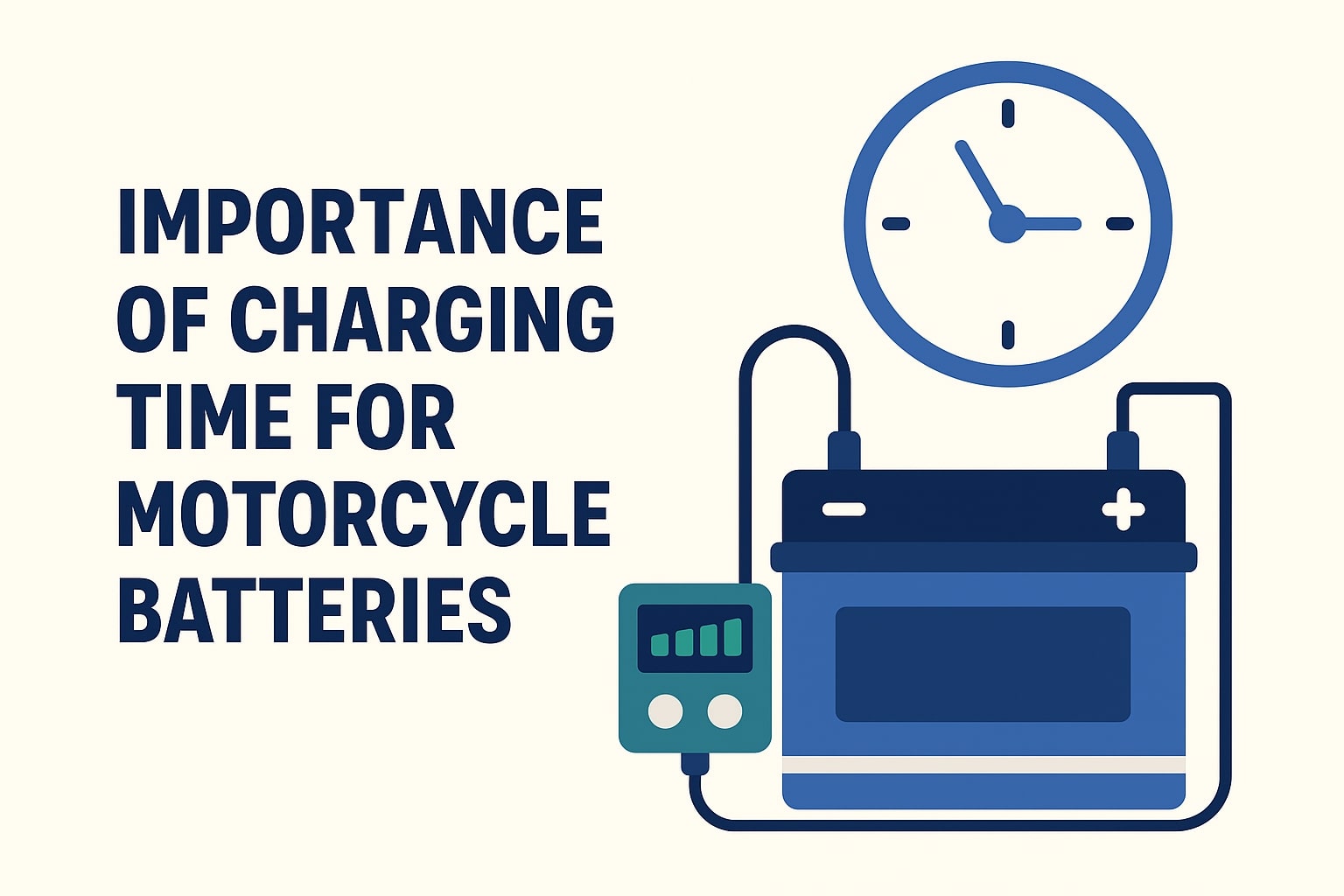
Let’s get one thing straight—charging time isn’t just about “filling up the tank.”
It’s a critical part of keeping your motorcycle battery healthy and long-lasting.
Back when I started riding, I used to charge my battery overnight, thinking it was harmless.
Spoiler alert: it wasn’t.
It got hot, lost charge faster, and gave me trouble on cold mornings.
Why Charging Time Actually Matters
Every battery goes through a chemical process during charging.
If you overcharge, those reactions continue even after the battery is full—which means excess heat, swollen cells, and eventually… a dead battery.
On the flip side, undercharging or using a weak charger might not give your battery the boost it really needs.
That’s what happens when you don’t know how long to leave motorcycle battery on charger correctly.
What Are Charging Cycles—and Why Should You Care?
Understanding how long to leave motorcycle battery on charger helps you avoid burning through limited charge cycles too quickly.
Each battery has a set number of charging cycles—basically, full charges from 0% to 100%.
If you overcharge or let it drain to near 0 often, you’re burning through those cycles faster.
And guess what?
Every cycle affects your battery’s amp-hour rating (Ah), which tells you how much power it can actually hold.
Abuse the cycle, and you reduce that capacity.
Real Talk: Good charging habits = fewer replacements, smoother starts, and no mid-ride breakdowns.
Relate: What is the charging time for a motorcycle battery?
How Long to Leave Motorcycle Battery on Charger
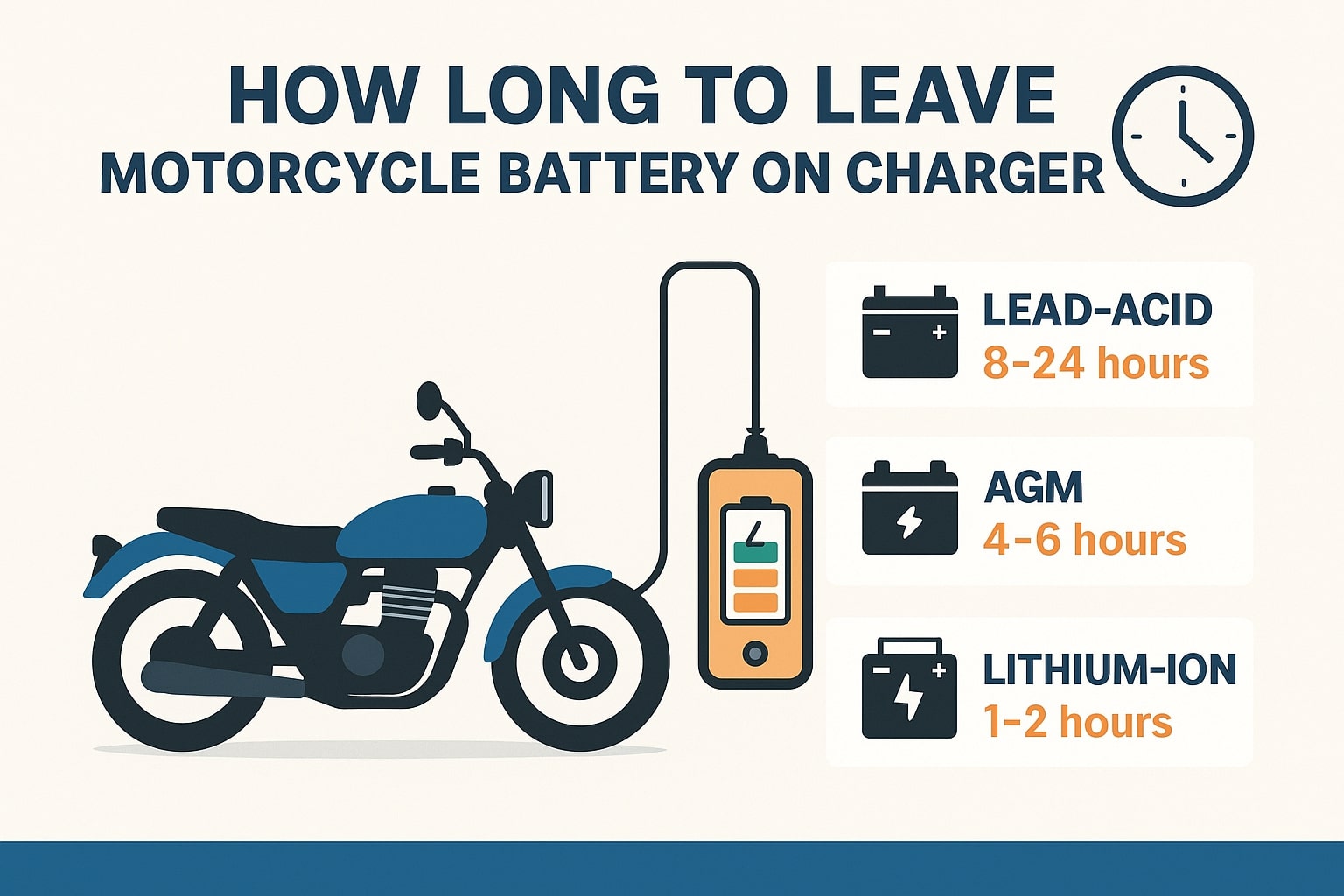
So, how long should you actually leave your motorcycle battery on the charger?
Well, the answer depends on a few important factors:
the type of battery, its condition, and the kind of charger you’re using.
Once you understand how long to leave motorcycle battery on charger for your battery type, it becomes easy to get it right every time.
Quick Rule of Thumb:
Lead-Acid Batteries: 8–24 hours
AGM Batteries: 4–6 hours
Lithium-Ion Batteries: 1–2 hours (with a lithium-specific charger only)
What Affects Charging Duration?
Here are the key things I always check before plugging in:
-
Amp-hour rating (Ah): Bigger batteries take longer to charge. For example, a 12Ah battery will take almost twice as long as a 6Ah one.
-
Battery age & condition: Older or sulfated batteries charge slower and might never reach 100%.
-
Type of charger: A smart charger adapts automatically. A basic charger? You’ll need to set a timer.
I always make sure I’m not just “topping off” a battery without checking the type first.
Leaving it on too long—especially with a manual charger—can cook the internals.
When in Doubt, Let the Smart Charger Decide
Smart chargers are the best option when you’re unsure how long to leave motorcycle battery on charger.
They’re designed to detect the battery’s level and shut off automatically once it’s full.
No need to guess, no risk of overcharging.
Pro Tip: If your charger doesn’t have auto shut-off, set a timer based on your battery’s amp-hour rating:
Charging time = Battery Ah ÷ Charger Amp Output
Example: A 10Ah battery on a 2A charger → 10 ÷ 2 = 5 hours
Smart Battery Charger for Motorcycles
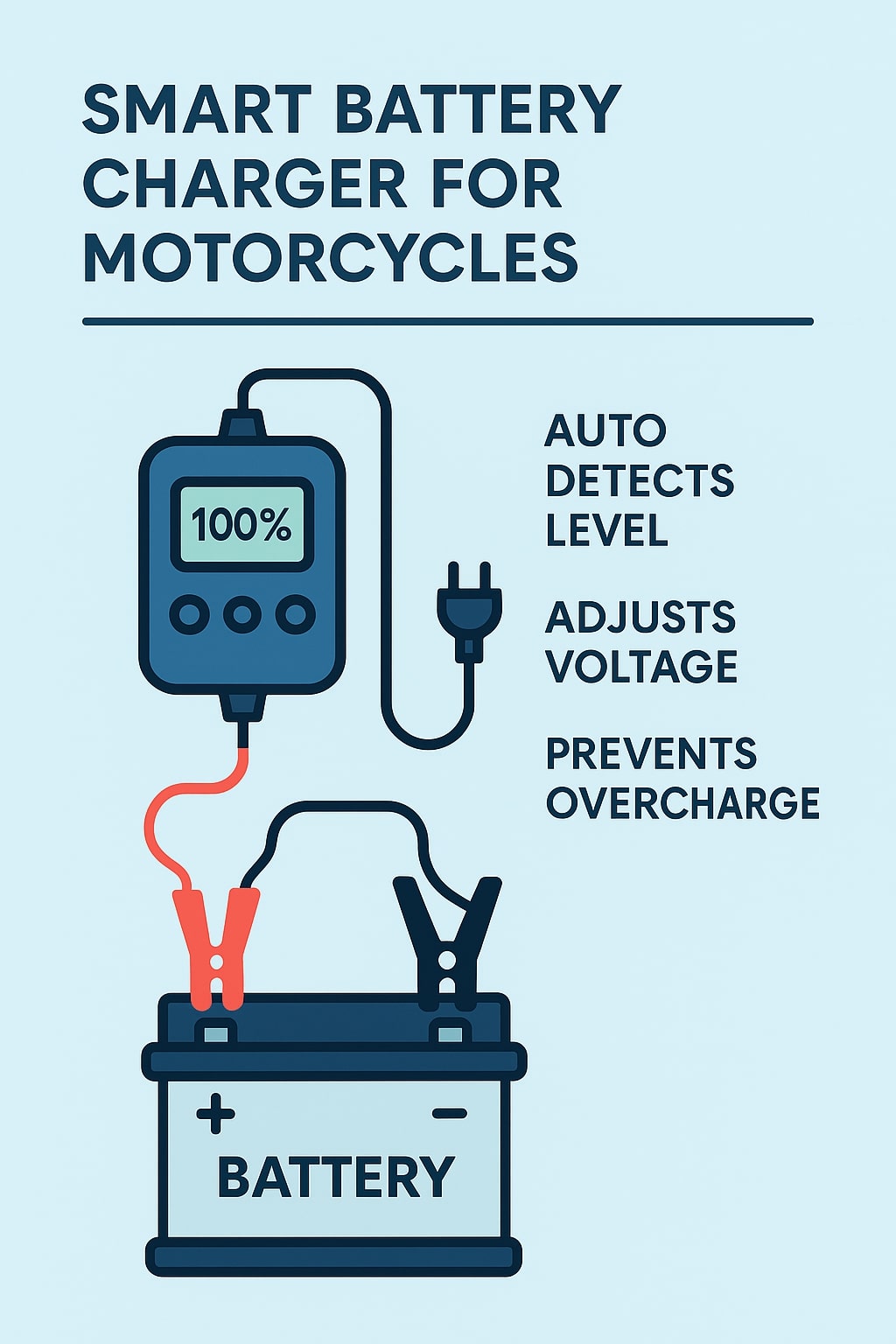
If there’s one upgrade that truly pays off for your motorcycle’s battery health—it’s getting a smart charger.
Think of it like cruise control for your battery:
it knows when to slow down, when to stop, and it never pushes too hard.
A smart motorcycle battery charger isn’t just a luxury—it’s a long-term investment.
It automatically senses your battery’s condition, adjusts the voltage accordingly, and shuts off the moment charging is complete.
No guesswork, no overheating.
What Makes It “Smart”?
Smart chargers use microprocessor-controlled technology to:
-
Monitor voltage in real-time
-
Switch between charging modes (bulk, absorption, float)
-
Prevent overcharging, even if left plugged in for days
-
Restore partially sulfated batteries in some cases
Bonus: Most smart chargers can safely maintain batteries for weeks or months using trickle or maintenance modes. Perfect for riders who store their bikes off-season.
Why I Personally Recommend Smart Chargers
There were times I didn’t ride for weeks. My lead-acid battery would drop below charge, and I’d be stuck jump-starting my bike before every ride. After switching to a smart charger, that problem disappeared.
These smart charger options are ideal when you’re trying to figure out how long to leave motorcycle battery on charger.
These devices are especially helpful when you’re unsure how long to leave motorcycle battery on charger, as they prevent guesswork and overcharging.
Real-World Tip: Mount a quick-connect cable on your battery so you can plug in your smart charger without removing anything—just plug and play.
Risks of Overcharging a Motorcycle Battery

Overcharging your motorcycle battery might not seem like a big deal—until it kills your battery months before it should’ve died.
Trust me, I’ve learned this the hard way.
When you leave a battery plugged in too long, especially with a non-smart charger, it keeps pumping in current even when the battery is full.
This generates excess heat, causes internal swelling, and even risks leaks or explosions in extreme cases.
Overcharging = Silent Battery Killer.
Common Signs You’re Overcharging Your Battery
If you spot any of these symptoms, it’s time to pull the plug—literally.
-
Battery feels hot to the touch even after unplugging
-
Leaking fluid or visible corrosion near terminals
-
Swollen or bloated casing
-
Battery drains faster than usual after a full charge
-
Electrical glitches—flickering lights or weak startup
How to Avoid Overcharging Your Motorcycle Battery
Many overcharging issues happen simply because riders don’t know how long to leave motorcycle battery on charger, especially with older manual units.
-
Always use a smart charger with auto shut-off
-
Match the amp setting to your battery’s size (don’t over-amp it)
-
Never leave a basic charger connected overnight
-
Monitor battery temp—if it gets hot, stop charging immediately
-
Charge in a well-ventilated space to prevent gas buildup
Pro Insight: A hot battery is never normal. If it feels warm while charging, that’s your cue to recheck your settings—or switch chargers.
Related: How Long to Actually Charge Motorcycle Battery? Quick Tips
Proper Way to Charge a Motorcycle Battery
Charging your motorcycle battery the right way isn’t rocket science—but doing it wrong can wreck your battery or worse, your electrical system.
Whether you’re a seasoned rider or just getting into bike maintenance, this step-by-step guide will save you time, money, and stress.
Step-by-Step: How I Charge My Motorcycle Battery Safely
1. Choose the Right Charger
First, check your battery type—lead-acid, AGM, or lithium-ion—and make sure your charger is compatible. Using the wrong charger can damage the battery or cause overheating.
Never use a lithium charger on a lead-acid battery—or vice versa.
2. Disconnect the Battery (If Needed)
While some riders charge the battery in place, I prefer disconnecting at least one terminal—especially on older bikes—to prevent accidental shorts or voltage spikes.
3. Clean the Terminals
A quick wipe with a wire brush or baking soda-water mix helps remove corrosion. Clean terminals ensure a solid connection and better charging performance.
4. Connect the Charger
-
Connect the positive (red) lead to the positive terminal first
-
Then connect the negative (black) lead to the negative terminal
-
Plug in the charger last to avoid sparks
5. Set the Correct Amperage
Follow the battery manufacturer’s recommendation. Typically:
-
1A–2A for small or standard batteries
-
4A–6A for high-capacity or fast charging (with proper smart charger)
6. Monitor the Charge
If you’re using a smart charger, it will handle this automatically. Otherwise, check every hour or two. If the battery gets warm, unplug it immediately.
7. Disconnect Safely
Once fully charged:
-
Unplug the charger
-
Remove the negative (black) clip first
-
Then remove the positive (red) clip
Pro Tip: Always read your battery and charger’s manuals. Some batteries require lower voltage, while others need temperature compensation for accurate charging.
How to Charge Different Motorcycle Battery Types
Not all motorcycle batteries charge the same way.
Each type—lead-acid, AGM, and lithium-ion—has its own quirks and charging needs.
Using the wrong method can reduce battery life or even damage it permanently.
Each type requires a different approach to charging, especially when deciding how long to leave motorcycle battery on charger.
Charging a Lead-Acid Motorcycle Battery
Lead-acid batteries are the most common, especially on older or budget bikes. They’re tough but need a little extra care.
Steps:
-
Use a basic or smart charger rated for lead-acid batteries.
-
Make sure the charging area is well-ventilated (they can emit gases).
-
Set charger to low amperage (1–2A) for slow, safe charging.
-
Monitor temperature and voltage; ideal full charge is 12.6–12.8V.
-
If you’re unsure how long to leave motorcycle battery on charger, a smart unit with auto shut-off is the safest bet.
Tip: Check electrolyte levels if your battery has removable caps. Top up with distilled water only.
Charging an AGM Motorcycle Battery
AGM (Absorbed Glass Mat) batteries are sealed and maintenance-free—perfect for riders who want reliable performance without fuss.
Steps:
-
Always use a smart charger that supports AGM mode.
-
Disconnect the battery from the bike (optional but recommended).
-
Select AGM or 14.7V charging mode, if your charger has one.
-
Charge with 1A–4A output, depending on battery size.
-
Watch for voltage rise but avoid heat build-up.
Never overcharge an AGM battery—this type is sealed and can’t vent excess pressure safely.
Charging a Lithium-Ion Motorcycle Battery
Lithium-ion batteries are lightweight, high-performance, and very sensitive to overcharging. You must use a charger made for lithium.
Steps:
-
Only use a lithium-specific smart charger.
-
Do NOT use regular lead-acid or AGM chargers.
-
Watch voltage closely—ideal is around 13.0V–14.6V, depending on battery specs.
-
Most lithium batteries charge within 1–2 hours, so monitor the process.
-
Check if your charger includes overcharge protection—this is a must-have.
Tip: If you ride seasonally, keep a lithium charger with storage mode to safely maintain battery health over time.
Bonus Tip: Quick Reference Table
Best Practices for Motorcycle Battery Maintenance
Proper motorcycle battery maintenance isn’t just about keeping your bike running—it’s about preventing premature battery failure, reducing replacement costs, and ensuring safe rides.
After years of riding and testing various battery types, I’ve developed a simple but effective battery care routine. Here’s what works.
Battery Life Extension Checklist
-
Inspect regularly
Examine your battery for cracks, leaks, or bloating every few weeks. Physical damage is often the first sign of internal failure. -
Clean battery terminals
Corrosion can block current flow and reduce starting power. Use a wire brush or terminal cleaner to keep contact points clean. -
Check charge levels
A healthy fully-charged battery should read 12.6–12.8 volts (lead-acid/AGM). Anything below 12.4V requires charging. -
Avoid full discharge
Never let your battery drop below 50% if avoidable. Deep discharges shorten the life of all battery types. -
Use a compatible charger
Always pair the right charger with your battery—and know how long to leave motorcycle battery on charger for safe results. -
Top up electrolyte (for non-sealed lead-acid)
Use only distilled water when electrolyte levels are low. Never overfill. -
Charge periodically during off-season
If your motorcycle is in storage, charge the battery once every 3–4 weeks or keep it connected to a smart trickle charger. -
Store in a temperature-stable area
Heat accelerates degradation, while extreme cold affects starting power. Choose a dry, shaded, and stable environment.
Safe Charging Practices
-
Only charge in well-ventilated areas to avoid gas buildup.
-
Never leave a manual charger connected overnight.
-
Set amperage based on battery size to prevent overheating.
-
Monitor charging temperatures. If the battery becomes hot, disconnect immediately.
-
Disconnect chargers in the correct order: power off → negative terminal → positive terminal.
Combine these practices with knowing how long to leave motorcycle battery on charger, and you’ll boost battery longevity.
Related: What is the charging time for a motorcycle battery?
Conclusion: How Long to Leave Motorcycle Battery on Charger
Understanding how long to leave your motorcycle battery on the charger isn’t just a technical detail—it’s a key part of maintaining battery performance, rider safety, and long-term reliability.
Throughout this guide, we’ve covered:
-
How long to leave motorcycle battery on charger depends heavily on battery type ((lead-acid, AGM, lithium-ion) and charger output.
-
Why using the correct charger is essential
-
The risks of overcharging and undercharging
-
Step-by-step methods for safe charging
-
Best practices to maximize battery life and prevent early failure
For most riders, the smartest move is to invest in a quality smart charger and follow a regular maintenance schedule.
Understanding how long to leave motorcycle battery on charger is one of those small habits that makes a big difference.
If you apply the strategies in this guide, you’ll avoid the most common battery-related issues and ride with more confidence—whether it’s your daily commute or your next long-distance tour.
FAQ
How long should I leave my motorcycle battery on the charger?
The duration depends on your battery type and the charger you use.
-
Lead-acid batteries typically require 8 to 24 hours using a standard or smart charger.
-
AGM batteries need around 4 to 6 hours.
-
Lithium-ion batteries charge much faster, usually within 1 to 2 hours, but must be charged with a lithium-specific charger.
If you’re using a smart charger, it will automatically stop once the battery is fully charged.
Can I leave my motorcycle battery on a trickle charger overnight?
Yes, but only if it’s a smart trickle charger with auto shut-off or float mode.
These chargers are designed to maintain a full charge without overcharging.
If you don’t know how long to leave motorcycle battery on charger, smart chargers handle that decision for you safely.
What type of charger is best for a motorcycle battery?
A smart charger is the best option.
It adjusts the voltage and current based on the battery’s condition and shuts off automatically when done.
This is especially helpful if you’re unsure how long to leave motorcycle battery on charger.
What are the risks of overcharging a motorcycle battery?
Overcharging leads to heat buildup, swelling, and reduced lifespan.
It happens most often when riders don’t know how long to leave motorcycle battery on charger or use a charger without auto shut-off.
What is the proper way to charge a motorcycle battery?
Use the right charger for your battery type.
Clean the terminals, connect cables correctly, and monitor the process.
Knowing how long to leave motorcycle battery on charger is key to preventing damage and ensuring full, safe charging.
How do I charge an AGM motorcycle battery properly?
Use a smart charger that supports AGM charging profiles.
-
Disconnect the battery from your motorcycle (optional, but safe).
-
Set the charger to AGM mode or use a voltage range of 14.4–14.7V.
-
Charge with an amperage suitable for the battery’s capacity, usually between 1A–4A.
-
Monitor the battery and avoid overcharging, even with smart chargers.
Can I use a lithium-ion charger on a lead-acid battery?
No. Lithium-ion and lead-acid batteries require different charging voltages and charging profiles.
Using a lithium charger on a lead-acid battery may cause undercharging or charger malfunction, while using a lead-acid charger on lithium can overcharge and damage the lithium cells.
Always use a charger specifically designed for your battery type.
How do I know when my motorcycle battery is fully charged?
Wondering how to tell when it’s time to stop?
Learning how long to leave motorcycle battery on charger makes this easier.
-
A voltage reading between 12.6V and 12.8V for lead-acid or AGM batteries.
-
The green “fully charged” indicator light on most smart chargers.
-
The battery no longer draws current or the charger enters “maintenance” or “float” mode.
What are the best ways to extend motorcycle battery life?
To maximize battery life:
-
Keep it above 50% charge—avoid deep discharges.
-
Use a smart charger, especially during off-season storage.
-
Clean terminals regularly to prevent corrosion.
-
Store the battery in a dry, cool, and stable environment.
-
Check voltage monthly with a digital voltmeter.
How should I store a motorcycle battery for the off-season?
Charge it fully, disconnect it, and store in a cool, dry place.
Even in storage, it helps to understand how long to leave motorcycle battery on charger to maintain optimal health and prevent sulfation.

